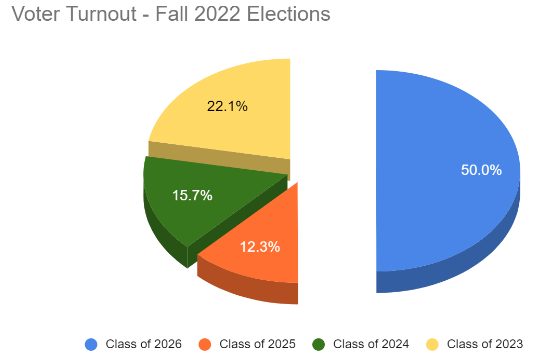Fall student elections received low voter participation, freshman class makes up 50% of voters
4 min read
Out of the 204 people who voted in elections, freshman made up 50%, sophomores 12.3%, juniors 15.7% and seniors 22.1%. | Callie Harkins, The Weekly Ringer
by PRIYA PATEL
Senior Writer
During the week of Sept. 12, the Student Government Association, Class Council, Finance Committee and Student Conduct Review Board all held elections to fill positions within their organizations. However, voter turnout was lower than student officials were hoping for.
According to Director of Student Activities and Engagement Sandrine Sutphin, 204 students voted in the election. “Of that, 50% were from the class of 2026, 12.3% were from 2025, 15.7% were from 2024, and 22.1% were from 2023,” she said.
SGA President Joey Zeldin, a senior political science major, believes this number is too low.
“It’s disappointing,” he said. “I believe we should be getting at least a third of our student body to vote in each of our elections. We had small numbers last election as well, and I am trying to focus on ways to allow students to engage with SGA more so that they understand to vote for more student representatives and advocate for issues on campus.”
While all four class years were represented by the candidates, turnout among upperclassmen was low. The freshman class made up half of all voters with the class of 2025 recording the least amount of voter participation.
“I think many people did not know about the elections for the upper-class,” said Nahjah Wilson, a sophomore political science major. Wilson serves as the Class of 2025 President and SGA Ethics and Oversight Committee Chair. “Also, the positions are usually taken, so many people in their classes probably did not know or paid any attention to the elections either.”
According to Zeldin, low turnout is not a new concept when it comes to campus elections, and participation among students mirrors the lack of voting in U.S. local government elections.
“This is a common theme, I believe,” said Zeldin. “As a political science major, I analyze these types of trends in voting in a lot of my projects and it mirrors the trends in other elections across the country. Freshmen have a lot coming at them at once and they’re trying to find what they like and what they want to do. Think of them as the younger generation of our campus. Our juniors and seniors are the older generation, meaning that their votes, in their minds, don’t matter as much and they won’t vote. I don’t agree with this philosophy, as I believe every vote on campus to be equally as important and valuable to our classes, but that tends to be electorate trends.”
Matthew Conard, a freshman known on campus as MC, had trouble filling out the ballot on his phone and believes that contributed to low turnout.
“Next time, they should make sure the format is compatible on phones because that’s how most students vote,” he said. “I spread the word about voting on my phone and I saw other people spreading the word the same way. I had people come up to me and be like ‘wait, how do I vote?’”
Sept. 10 to Sept. 15 was designated as a campaigning period for students who applied to run in the fall elections. Wilson believes this time could be better utilized in the future.
“I do think that the campaigning should be a bigger deal because I know how hard it is to get people to vote, especially to get people to vote for you,” she said.
Voting in campus-wide elections is not the only way in which upperclassmen participation has declined.
“There was a lapse in student engagement within student clubs and organizations due to the pandemic, specifically with 2023 and 2024,” said Zeldin. “I believe this to also be a large factor in why the younger classes are voting and engaged more overall, as the university incentivizes participation with incoming classes more than it does the older classes.”
The majority of student leaders are elected near the end of the spring semester. The elections conducted in the fall fill in the remaining positions, including those that need to be filled by the freshman class.
“Think of our spring elections as [a] general election and the fall elections as midterm elections,” said Zeldin. “Spring elections generally involve the election of organization leadership, as well as the reelection of various positions on campus. My election for president was this past spring, but there won’t be another presidential election for SGA until spring 2023.”
Zeldin said fall elections specifically aim to get freshmen, transfer students and students who are newly interested in student government involved, whether it be in voting or running for a position. Once these students are voted into a student government position, they often move up in the future.
“Typically for SGA, we see incumbent senators move up within the organization to higher positions, meaning that once they’re elected in the spring, they’re able to start getting work done immediately,” he said.
Zeldin emphasized the importance of voter participation within campus elections and encourages more students to vote in future elections.
“It is so important to vote in student elections, because much like your local, state, and federal elections, we make change,” he said. “The more you vote and get involved, the more power we have to make that change. SGA is amped for a great year of engaging with the community and creating legislation to make large changes, and I hope our student body is ready to ask them the questions that matter most to them so we can accomplish our mission of being their voice.”
Callie Harkins contributed to reporting for this article.


